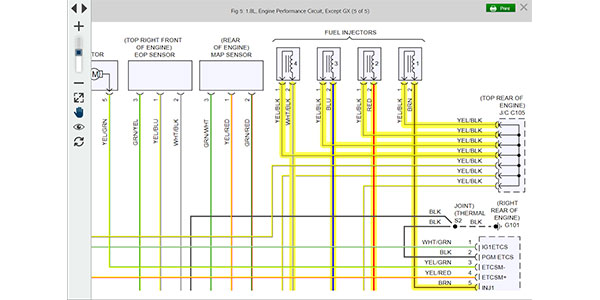By Larry Carley
Technical Editor
With all the talk about global warming and climate change, many people are wondering what the future holds for R-134a as an automotive refrigerant. R-134a was introduced back in the early 1990s as an “ozone safe” replacement for R-12. Unlike R-12, R-134a contains no chlorine, so it can’t harm the ozone layer that protects us from the sun’s ultraviolet radiation. But R-134a absorbs and retains heat, which makes it a “greenhouse gas” that may contribute to global warming. Consequently, automakers and legislators are looking at options that would minimize or eliminate the environmental impact of R-134a on this latest environmental issue.
Most of the focus has been on carbon dioxide (CO2), which has the most impact on heat retention and global warming. CO2 is a byproduct of combustion and is released when fossil fuels such as gasoline, fuel, oil, natural gas, coal or wood are burned.
Scientists say atmospheric levels of CO2 naturally fluctuate up and down a few percentage points over thousands of years. But in recent years, they have measured and documented an alarming rise in CO2. They say that CO2 levels have now reached an all-time high of 383 parts per million by volume, which is higher than any other period in the past 100,000 years! And this, they say, has caused average world temperatures to rise almost 2° F in the past five years. The fear is that global warming is already starting to cause changes in the climate that will increase droughts, floods, extreme weather, and have dire and unpredictable consequences for many species (including our own).
To minimize the human impact on global warming, scientists, legislators and automakers are all looking at ways to reduce CO2 emissions as well as the release of other greenhouse gases including R-134a refrigerant. The thermal characteristics that make R-134a an excellent refrigerant also make it a bad greenhouse gas. R-134a has a global warming potential (GWP) that’s 1,300 times higher than CO2. Consequently, every pound of R-134a that leaks into the atmosphere has the same effect on global warming as does 1,300 pounds of CO2 from any other source.
According to a November report by the Energy Information Administration, vehicles in the U.S. leaked 50.8 thousand tons of R-134a into the atmosphere, equivalent to more than 66 million tons of greenhouse gases. The emissions are 7% higher than in 2004, and up 273% since 1995.Though these numbers sound alarming, refrigerant leaks from automotive A/C systems actually account for less than 1% of total global greenhouse gas emissions. Still, it contributes to the overall problem, so various solutions are being considered to reduce or eliminate R-134a’s impact on the environment.
ONE SOLUTION
The North American and Japanese automakers currently have no plans to replace R-134a with any other refrigerant. But they are redesigning their next generation A/C systems to accomplish the following goals:
• To use less refrigerant. Some newer A/C systems now use only 12 to 14 oz. of refrigerant, which is much less than the 24 to 60 oz. charges used by most older A/C systems. As time goes on, we will see more and more of these low-capacity A/C systems in new vehicles.
• To reduce refrigerant leakage 50% over the life of the vehicle. This requires using improved seal designs, hoses and O-ring connections.
• To improve cooling efficiency 30% with more efficient condensers, compressors and operating strategies (things like variable displacement compressors that run all the time rather than cycle on and off). Mercedes currently has this in place.
• To reduce the cooling requirements inside the passenger compartment 30% by using reflective coatings on glass, heat-reflective paint and venting the interior during hot weather.
On the service side, changes are also being made to reduce refrigerant loss when the vehicle is brought in for repairs. The latest generation of refrigerant-recovery machines do a better job of removing all of the refrigerant from the system. Older machines can leave as much as 20-30% of the refrigerant charge in the system. This means the unrecovered refrigerant will escape into the atmosphere when the system is opened to replace parts. Some of the newest machines can pull up to 95% of the refrigerant out of the system to reduce residual refrigerant losses.
In recent years, Mazda and some of the other vehicle manufacturers have been adding leak detection dye to the factory refrigerant charge. This allows technicians to see leaks with an ultraviolet (UV) lamp (also called a “black lamp” because of its purple-colored light). The dye remains in the system and circulates with the refrigerant indefinitely or until a leak occurs. A leak will leave a telltale stain that glows greenish-yellow or greenish-blue when illuminated with a UV light source. With this approach, leaks as small as 1/8 oz. of refrigerant per year can often be detected.
Electronic leak detectors are also getting better. New SAE J2727 leak detection standards require these tools to detect R-134a leaks as small as 0.25 oz. (7 grams) per year. Some detectors can find leaks as small as 0.1 oz. per year.
Recharging equipment is also getting smarter and more accurate. As A/C systems are downsized and charging capacities are reduced, charging accuracy becomes more important than ever before for good cooling performance. The latest generation of charging equipment can charge to within 3 oz. or less of specifications.
OTHER ALTERNATIVES
In Europe, things are moving in a different direction. The Europeans have decided to phase out R-134a and to replace it with something else. The phase out in new vehicles will begin in 2011 and be complete by 2017. After 2017, R-134a will be allowed only when servicing older vehicles. What’s more, the law will not allow vehicles with leaky A/C systems to be recharged with R-134a until the leaks have been fixed.
The new European fluorinated “F-Gas” regulations call for using a refrigerant that has a global warming potential of 150 or less, which currently leaves just two possibilities:
1. HFC-152a, a refrigerant with a GWP of 140.
HFC-152a has cooling characteristics very close to that of R-134a, and could probably be used as a direct substitute for R-134a with few, if any, modifications. But HFC-152a has one drawback: It is flammable. If the refrigerant leaks into the passenger compartment, it could explode. The EPA currently bans flammable refrigerants for mobile A/C use (except in truck refer trailers), and many states also have laws that prohibit their use.
Possible solutions to the flammability issue include using a leak sensor inside the vehicle that would warn the passengers and open the windows if a leak occurred. Another approach would be to design a “secondary loop” A/C system that keeps the flammable refrigerant in the engine compartment. The refrigerant would circulate through an intermediate heat exchanger and chill a liquid (ethylene glycol antifreeze) that flows through the HVAC unit inside the car.
2. R-744, which is straight CO2.
CO2 has a GWP rating of 1, which is the lowest of any alternative refrigerant currently under consideration. CO2 does not absorb heat as well as R-134a, R-12 or HFC-152a, so it requires much higher operating pressures — up to 2,000 psi, which is nearly 10 times as high as R-134a! This, in turn, requires a totally redesigned A/C system with much more rugged parts, and all new service equipment that can recharge at such high pressures and detect CO2 leaks.
Tests have shown that the compressor on an A/C system charged with R-744 has to work much harder, which may cause it to use more energy to achieve the same degree of cooling. This hurts fuel economy. Consequently, the savings of using CO2 as a refrigerant to reduce global warming may be offset by increased fuel consumption and CO2 emissions produced by the engine. Even so, proponents of R-744 say a properly designed CO2 A/C system can achieve 20% overall fuel savings, and reduce overall CO2 emissions as much as 9 grams per mile.
While the engineers continue to refine CO2 A/C systems, European officials are calling for tighter R-134a systems, with leakage not to exceed 40 grams per year for a single evaporator system, or no more than 60 grams per year for a dual evaporator system. For the first time, service facilities will also be required to have trained and certified A/C technicians, refrigerant recovery and recycling equipment, and mandatory repairs before leaky A/C systems can be recharged. The Europeans may also ban the sale of R-134a in small cans to discourage DIY recharging. California has proposed a similar ban on the sale of small cans of R-134a to DIYers, but the proposal is still being debated.
What about other alternative refrigerants, such as propane, butane or other hydrocarbons? Many of these chemicals make excellent refrigerants, but because they are flammable they are considered too dangerous for automotive applications. The EPA does not approve flammable refrigerants, and they are illegal to use in 19 states. There is also a risk of fire if the condenser is ruptured in a frontal collision.
DOWN THE ROAD
The future of R-134a will depend on several things. If the automakers can make A/C systems more energy-efficient and more resistant to refrigerant loss as vehicles age, there may be less pressure to switch to an alternative refrigerant. On the other hand, if Europe continues to move ahead toward R-744 and there is increasing political pressure to “do something” about global warming, automakers may have no choice but to replace R-134a with HFC-152a or R-744.
Any such change is still years away, and would likely involve a gradual phase-in period. But if and when such a change occurs, it would require a considerable investment in training and equipment to service the new refrigerant(s). Some type of certification for the new refrigerant(s) may also be required.
But all this spells “service opportunity” for shops with the right equipment and properly trained technicians.






